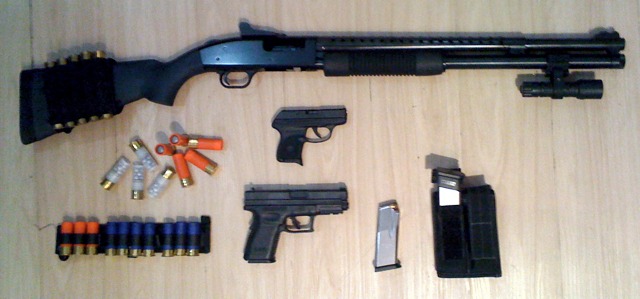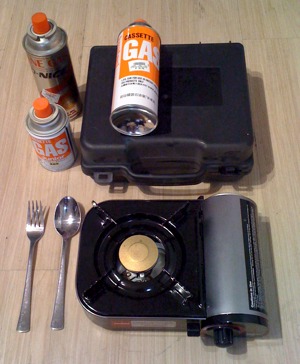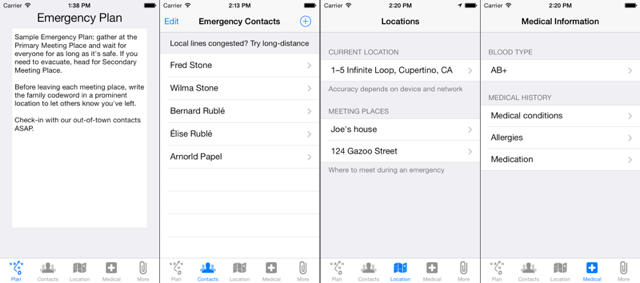I have not seen any of the mainstream preparedness information resources discuss the effectiveness of firearms for self-protection after a major disaster. Usually it is left to the niche survivalist sites to tackle. Perhaps the subject is too politically sensitive for large organizations. Generally, the focus is simply on stocking up on supplies, making a plan and then taking your lead from 'The Authorities'. Unfortunately, recent examples have shown that for some time after a disaster, the authorities are often nowhere to be seen. Looting and violent crime surge while ordinary people are left to fend for themselves against criminals. After Hurricane Katrina in 2005, New Orleans
suffered from widespread looting. Survivors of the Chilean Earthquke of 2010 were forced to form their own local watch group against criminals,
arming themselves with makeshift weapons. In Haiti,
criminals fought with other earthquake survivors over scarce resources. One Haitian witness said,
"All the policemen are busy rescuing and burying their own families. They don't have the time to patrol the streets." Interestingly, the
2011 Earthquake in Japan proved to be an exception. There, the quake victims were orderly, looting was almost non-existent and even the
Yakuza enforced order while helping to
distribute relief goods.
Post-disaster Manila will not be orderly
Will a post-disaster Manila more resemble Japan or Haiti? It's silly even to pose the question when we have, as a normal occurrence,
akyat-bahay (house intruder) gangs who sneak into homes, sometimes killing the occupants for low value items. Of course, there's a place for expecting the best out of your fellow man and people often pull together during adversity. Just don't rely on this happening. It seems likely that desperation will cause more people to use violence on others. In particular, the people who've taken the effort to prepare beforehand may become a target of envy from those who did nothing, or those unfortunate enough to have lost everything. We must accept the fact that people may want to do us harm and there is no tool more effective at repelling them than a firearm in the hands of a trained person. Sticks, pepper-spray, unarmed self-defence and strong words all have their place but only a firearm enables a weaker person to repel several stronger attackers.
Get a gun, learn how to use it
I realize that advocating this is controversial but I would be doing you a great disservice by simply ignoring the topic. If you are at all serious about preparedness, you need to get a gun and learn how to use it. Preparedness includes being ready to protect yourself, your family and your property. There's little point in stocking up on supplies when everything can be taken away by a street thug or desperate mob. Let me be clear, however, that using your firearm against an adversary should obviously be considered the absolute last option; there are many, many things you can do to avoid that situation altogether. Nevertheless, dealing with reality means acknowledging that the danger exists. Some believe that the best way to protect people is to strive for a 'gunless society'. While they are entitled to their point-of-view, these well-meaning people are sadly misguided. A deeper discussion
belongs elsewhere so all I will say here is that if a major disaster hits the Philippines,
our society will definitely not be gunless. Fortunately, Filipino civilians can legally own firearms and the country has an active sport shooting culture so there are many information sources available. If you are a novice, do yourself a big favor and join a gun club. There you can get more information about training and legally purchasing a firearm.
Armscor,
Jethro and
Stronghand are just a few of the the more popular clubs in Manila.
Types of firearms useful in a disaster
The subject of which types of firearms for a disaster sitauation can, on its own, cover many articles and generate heated debate. I'll just give you a summary of my opinion on the matter. 'Prepper' and survivalist sites, usually US-based, often advocate that you should have three types of firearms: a handgun, a rifle and a shotgun. Their reasoning is that this covers you for the range of uses from concealed carry and home defense to hunting game for food. I don't think this advice quite applies to Manila residents. First of all, the only 'game' you're likely to hunt will probably be disease-ridden rats, cats and dogs. Secondly, the tight confines of our city would mean that the longer range of a rifle may pose a risk to innocent people if you miss your target. (And if someone is at a distance where you'd need a rifle, they're not likely to pose an immediate danger so why would you be shooting at them?) Personally, I believe that the best combination for those of us living in Manila is the handgun and shotgun. A handgun can be kept with you at all times and easily concealed so as not to cause alarm. The shotgun provides more power while being reasonably priced and versatile. Shotgun shells are also widely available and cheaper than rifle ammunition.

Firearms for home protection after a disaster: Mossberg 500 with a variety of loads, Springfield XD 45 and Ruger LCP pistols
Many Filipino preppers, like their American counterparts, are also fans of what are classed in the Philippines as 'high powered rifles' (HPRs). Examples of these include the
AR-15,
M4 (technically a
carbine) or
AK-47. Some tend to look down on the shotgun as an inferior cousin and believe that you must have a HPR for any serious civil unrest situation. If your situation allows you the opportunity to own a carbine or high-powered rifle, great; there's nothing wrong with having more tools in your toolbox. However, these are expensive and the sale of HPRs to civilians are restricted. The expense and effort it takes to procure one may be better spent on other areas, like learning
first aid or buying food and medical supplies.
Choose what suits your situation
Ultimately you should choose what suits your situation while considering what's most likely to happen. A major earthquake or flood is unlikely to turn Manila into a war zone so stocking up like Rambo may not be the best use of your resources. However, it's prudent to expect a rise in violent crime like looting, hold-ups, rapes and armed home invasions. Also remember that
those who are most at risk would be the weaker members of your family such as children, grandparents and especially women. You may not be around to protect them so it's important to ensure that they're capable of protecting themselves. Firearms do this more effectively than any other tool.
Please practice peaceful and responsible firearms ownership
Remember to observe the four rules of firearm safety:
- Always assume that the gun is loaded.
- Never let the muzzle cover anything you are not willing to destroy.
- Keep your finger off the trigger until your sights are on the target.
- Be sure of your target and what is beyond it.
For more information, please visit
progun.ph
Continue Reading




